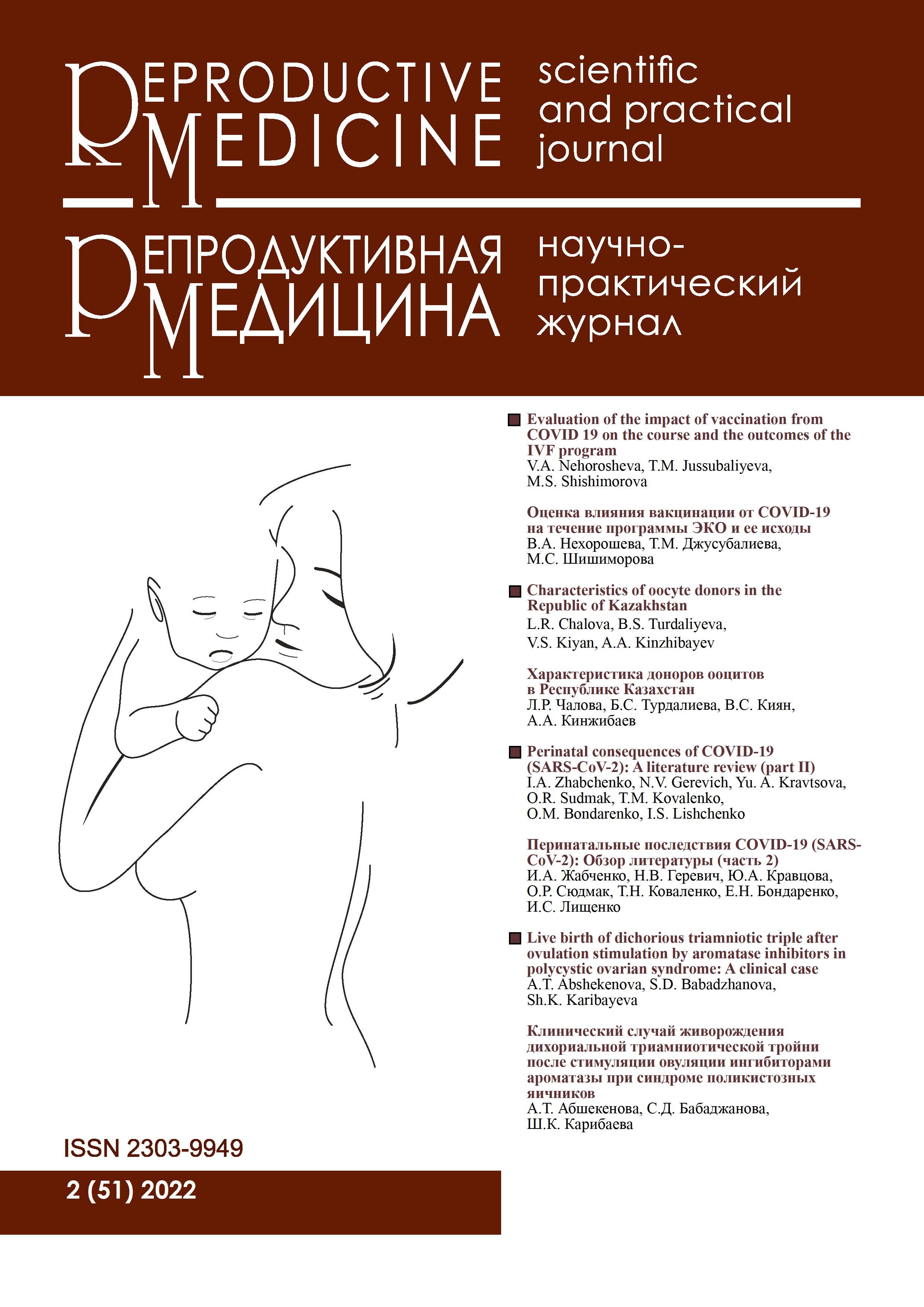Pregnancy outcomes in patients with tubal infertility after laparoscopic treatment
DOI:
https://doi.org/10.37800/RM.2.2022.70-76Keywords:
laparoscopy, tubal infertility, pregnancy rate, tubal pregnancyAbstract
Relevance: The frequency of infertile marriages in Kazakhstan varies within 15%. This is about 20 thousand couples, that is, every sixth family in Kazakhstan is infertile. To solve this problem in 2021, it became possible to conduct IVF under the
state program «Ansagan Sabi». By 2022, the number of quotas for this program has grown to 7 thousand. However, in the case of tubal infertility factor, there is a chance of achieving a natural pregnancy after minimally invasive surgery.
The aim of the study was to analyze pregnancy outcomes in patients with tubal factor infertility after laparoscopic treatment.
Methods: The study included 190 patients who underwent laparoscopy for TFB in the period from February 2018 to January 2019 in the Department of Operative Gynecology of the Regional Obstetrics and Gynecological Center (RAGC) in
Karaganda. The patients were divided into groups depending on the severity of pelvic adhesions, hydrosalpinx, and fimbria structure. The study analyzed the influence of fallopian tube diseases on postoperative outcomes of spontaneous pregnancy after laparoscopic treatment.
Results: Pregnancy occurred in 88 out of 190 patients included in the study (pregnancy rate – 46.3%). It was found that pelvic adhesions, hydrosalpinx and damage to the fimbriae of the fallopian tubes affect the frequency of natural pregnancy after surgery. In 19 cases out of 88 (21.6%), an ectopic pregnancy was recorded. Peritubal adhesions and damage to the pili structure significantly increased the incidence of postoperative ectopic pregnancy (p<0.001).
Conclusion: It has been determined that pelvic adhesions, peritubal adhesions, hydrosalpinx, and damage to the fallopian tube fimbriae can influence postoperative pregnancy outcomes and lead to the absence of a natural pregnancy after surgery. The frequency of ectopic pregnancy increases with the degree of adhesions in the pelvis and the degree of damage to the fimbriae of the fallopian tubes.
References
Статистический сборник «Здоровье населения Республики Казахстан и деятельность организаций здравоохранения в 2017 году» [Statisticheskij sbornik «Zdorov’e naseleniya Respubliki Kazaxstan i deyatel’nost’ organizacij zdravooxraneniya v 2017 godu» (in Russ.)]. http://www.rcrz.kz/files/sbornik/sbornik_2018.doc.
Павлова Т.В., Бирюкова Е.А., Струкова С.А. Особенности течения беременности и родов у женщин с одноплодной и многоплодной беременностью после экстракорпорального оплодотворения // Материалы Всероссийской конференции с международным участием «Охрана репродуктивного здоровья - будущее России». 11-12 марта. – 2010. – С. 70-73. [Pavlova T.V., Biryukova E.A., Strukova S.A. Osobennosti techeniya beremennosti i rodov u zhenshhin s odnoplodnoj i mnogoplodnoj beremennost’yu posle e’kstrakorporal’nogo oplodotvoreniya // Materialy Vserossijskoj konferencii s mezhdunarodnym uchastiem «Oxrana reproduktivnogo zdorov’ya - budushhee Rossii». 11-12 marta. – 2010. – S. 70-73. (in Russ.)].
Sun F., Yang S., Yang Y., Liu X., Xu H. Laparoscopic Management of 42 Cases of Tubal Stump Pregnancy and Postoperative Reproductive Outcomes // J. Minim Invasive Gynecol. – 2020. – Vol. 27(3). – P. 618-624. https://doi.org/10.1016/j.jmig.2019.04.030.
Rana P., Kazmi I., Singh R., Afza, M., Al-Abbasi F. A., Aseeri A., Anwar F.. Ectopic pregnancy: a review // Arch. Gynecol. Obstet. – 2015. – Vol. 288(4). – P.747-757. https://doi.org/10.1007/s00404-013-2929-2.
He L.Q., Cai X.Z., Wang Y., Wang X.F. Effect of GnRHa therapy following conservative laparoscopic surgery for endometriosis on clinical pregnant rate in patients with endometriosis-associated infertility // Nan Fang Yi Ke Da XueXue Bao. – 2018.– Vol. 38(5). – P. 596-600. https://doi.org/10.3969/j.issn.1673-4254.2018.05.15.
Yuan L., Jingying H., Xiujuan C., Chengying L., Xiaochen H., Xiume X., Yulong Z., Zihua C. Predictive value of a modified classification of fallopian tube status on prognosis of tubal factor infertility after laparoscopic surgery // Medicine – 2019. – Vol. 98 (13). – P. e14952. https://doi.org/10.1097/MD.0000000000014952.
Domali E., Mantzioros R., Kathopoulis N.,. Stavrou S., Besharat F., Poumpouridou A., Drakakis P., Loutradis D. P14.04: Laparoscopic treatment of ectopic tubal pregnancy: an old fashion approach? // Ultrasound Obstet. Gynecol. – 2019. – Vol. 54 – P. 199-200. https://doi.org/10.1002/uog.21012.
Gao M.Y., Zhu H., Zheng F.Y. Interstitial Pregnancy after Ipsilateral Salpingectomy: Analysis of 46 Cases and a Literature Review // J. Minim. Invasive Gynecol. – 2020. – Vol. 27(3) – P. 613-617. https://doi.org/10.1016/j.jmig.2019.04.029.
Downloads
Published
How to Cite
Issue
Section
License
The articles published in this Journal are licensed under the CC BY-NC-ND 4.0 (Creative Commons Attribution – Non-Commercial – No Derivatives 4.0 International) license, which provides for their non-commercial use only. Under this license, users have the right to copy and distribute the material in copyright but are not permitted to modify or use it for commercial purposes. Full details on the licensing are available at https://creativecommons.org/licenses/by-nc-nd/4.0/.




